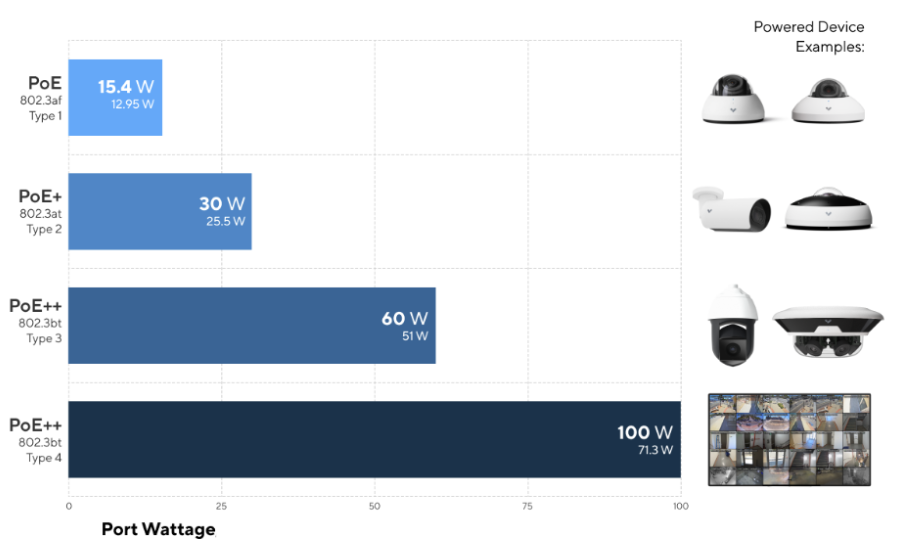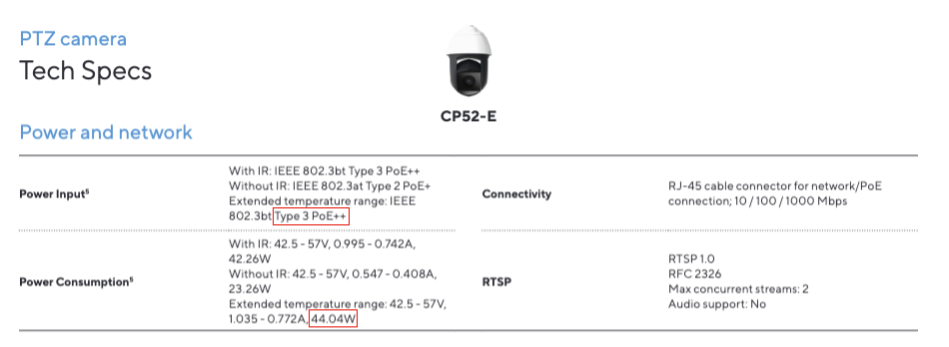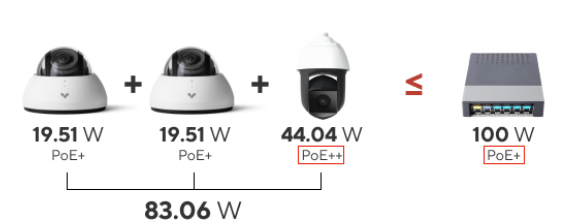By Marcus Orciuch, Solutions Engineer
Overview
Power over Ethernet (PoE) is an electrical technology used to transmit both power and data over a single ethernet cable. Defined by the Institute of Electrical and Electronics Engineers (IEEE) as 802.3af, 802.3at, and 802.3bt, PoE simplifies the installation and maintenance of IoT devices by requiring a single cable to deliver both power and network capabilities to powered devices.
Additionally, an organization adopting PoE wherever possible can centrally manage DC power to a multitude of devices, as opposed to managing an individual AC power supply for every device. Common applications of PoE include physical security, voice-over IP (VOIP), and networking equipment.
Different Types of PoE
Different classifications of PoE are used depending on how much power a powered device requires. As of September 2018, IEEE defines 4 different types of PoE, with the key distinction being the amount of power delivered to a port.
The wattage delivered to the port of a PoE-enabled power supply, called port wattage, differs from the amount actually delivered to the powered device. The wattage at the device can be 10-25% lower than the port wattage due to heat dissipation in-transit. Cable length is the largest contributing factor to this, so it is recommended that cable runs be under 100 meters.

PoE (802.3af) Type 1 is used for low-power consumption devices, such as interior security cameras, VOIP phones, and edge network devices. Via Cat3 (or above) ethernet cabling, type 1 can deliver up to 15.4 watts of power, or an effective 12.95 watts at the powered device.
PoE+ (802.3at) Type 2, is typically used for devices with slightly more demanding functionality, such as security cameras that include a built-in heater, video-enabled VOIP phones, and certain alarm systems. Via Cat5 (or above) ethernet cabling, type 2 can deliver up to 30 watts of power, or an effective 25.5 watts at the powered device.
PoE++ (802.3bt) Type 3/4, is used for high power utilization devices, such as motorized security cameras, digital signage, and displays. Via Cat5 (or above) ethernet cabling, type 3 can deliver up to 60 watts of power, or an effective 51 watts at the powered device, while type 4 can deliver up to 100 watts of power, or an effective 71.3 watts at the powered device.
Do I have enough power for my PoE devices?
At a high level, the wattage provided by all power-producing devices should always be at or above the maximum wattage required by all powered devices. Devices are rarely at maximum power consumption, however, if one doesn’t consider the maximum wattages, one could risk an overload on power-producing devices, resulting in downtime.
Take inventory of your PoE devices, as well as their respective PoE classification and max power consumption. These specifications can be found within a device’s datasheet. Once power requirements are collected, power-producing devices, such as network switches, can be determined for procurement.

Consider the following scenario: if a physical security deployment consists of 5 Verkada CD62 outdoor dome cameras, the total max power consumption is 97.55 watts.

A PoE+ network switch with a power availability pool of 100 watts could comfortably support these devices, with about 3 watts of surplus in the worst case that every device is at peak power consumption.
Power-producing devices must at least match or exceed the PoE classification of a powered device, otherwise, a device may be underpowered and lose functionality. For example, Verkada’s pan-tilt-zoom (PTZ) camera, the CP52-E, requires a PoE++ power source. If provided PoE or PoE+ instead of PoE++, the camera will record video without pan-tilt-zoom capabilities, as not enough energy is provided by the switch for motor control.

Now consider a different physical security deployment scenario, which includes 2 of Verkada’s CD62 outdoor dome cameras and 1 of Verkada’s CP52-E PTZ cameras. The maximum consumption of the dome cameras is 39.02 watts and 44.04 watts for the single PTZ camera, which is 83.06 watts combined. If utilizing the same PoE+ switch as previously, one may think the deployment should be under budget by about 17 watts, even when considering max consumption.

This is incorrect; even though this setup is under budget, the PTZ camera will not completely function. This is because the PoE classification of the PTZ camera exceeds the classification of the network switch. Not all power is delivered equally: devices with higher PoE classifications expect higher power throughput, also known as current. In this scenario, the switch is unable to provide enough voltage at a fast enough current due to this mismatch in PoE classification.
What happens if I don’t have enough power?
Ideally, proper project scoping and management should avoid PoE deficits. However, procuring network switches with specific PoE capabilities can be costly, especially if only one device is in an invalid power state. In these circumstances, it is preferred to use a PoE Injector to power that single device directly. Injectors are typically used as patchwork in existing environments with scarce unallocated PoE resources, or in environments without any PoE infrastructure.
These devices take two inputs: an ethernet cable providing the injector data and a power cable providing the injector power, and have a single PoE output.